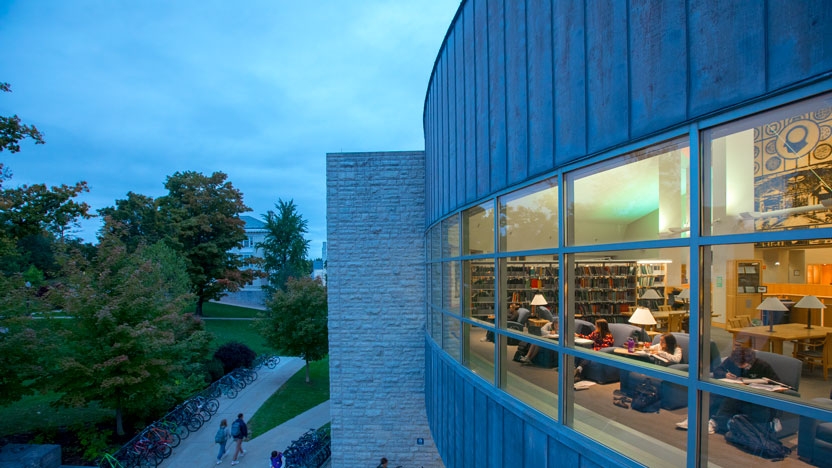Davis Family Library

When the College needed a new library, the trustees selected the front quadrangle as the best site and decided to remove the existing former Science Center, as it was deemed structurally impractical.
Deconstruction
Middlebury consciously selected a deconstruction process to minimize negative impacts to the community (noise, dust, truck traffic) and maximize resource recovery. More than 90 percent of the old building was diverted from landfills though salvage, reuse, and recycling. In addition, four historic homes were relocated to College-owned sites within the village and then renovated. The College received the 2002 Vermont Governor’s Award for Environmental Excellence for its leadership in construction and demolition waste minimization.
Lighting
Because more than 50 percent of the electrical demand in the Davis Library is due to lighting, natural light from windows and skylights and energy-efficient lighting help minimize electricity use. Lighting in some parts of the library is also controlled by daylight sensors that turn the lights up or down depending on the amount of natural light measured in the space. Office areas and meeting rooms are equipped with occupancy sensors to turn off the lights when the room is unoccupied. Vending machines are equipped with VendingMisers, devices that shut off the display lights when no one is around.
Climate Control
Designed to meet Middlebury’s needs for the next 100 years and protect its extensive collections, the library’s climate control system was essential. The College invested in the thermal qualities of the building envelope, high efficiency windows, air lock vestibule entrances, and a mechanical system featuring premium efficiency motors and heat recovery.
Local Wood and Furnishings
The library features 150,000 board feet of Vermont-harvested hardwood—70 percent came from the College’s Bread Loaf certified forest and all was processed in Vermont. Middlebury awarded several contracts to local vendors, including woodworkers and furniture manufacturers. The Northeastern Loggers’ Association awarded Middlebury their 2003 Outstanding Use of Wood Award, in part because of this project.
Storm Water Management
Storm water runoff is a major source of pollution in Vermont waterways. The library site cleans and reduces its runoff and protects downstream regions through a system of collection areas, wet meadows, and swales, which are planted with ferns and irises to naturally filter water and allow it to soak into the ground where it is available for plants.
Landscape Design
Landscape architects Andropogon Associates Ltd. redesigned the front quadrangle of campus, creating paths to accommodate new patterns of pedestrian traffic and to highlight views of campus. Thirty-five additional trees, selected from species native to Vermont, were planted. Wheelchair access is provided from Old Chapel Road to the main library entrance by a path that curves down and around a radial plaza. The plaza conforms to the building geometry and features a series of stone steps cut from large pieces of Vermont limestone. Bicycle racks encourage alternative transportation and a pedestrian-oriented campus.
Reading Garden
The Committee on Art in Public Places selected sculptor Michael Singer to design a reading garden in the front quad to the south of the library. Materials used in the “Garden of the Seasons” include Vermont granite and copper-coated cast aluminum in a juxtaposition of the natural and manmade which is a signature of Singer’s work. The project incorporates water features as well as native plantings in a manner that highlights the qualities of these elements at different times of the year.

